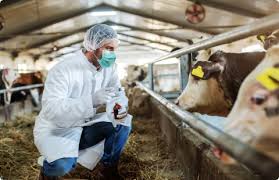Treatment of sick animals is carried out only after a diagnosis has been made of the condition affecting the animal. Treatment can involve the application of drugs, biological substances, and/or surgical intervention to ameliorate or prevent a specific ailment or condition.
When treatment is required, care should be taken to select the appropriate drug, dose, frequency of administration, route of administration, and the form in which the drug appears in order to achieve the desired result.
The choice of treatment, especially for food animals like ruminants, should also take into account public health, environmental, or regulatory concerns.
Treatment is usually done using conventional Western drugs, and in some cases, indigenous knowledge-based practices, now known as Ethnoveterinary Medicine
Read Also: The Yams Pistil: Economic Importance, Uses, and By-Products
Routes of Drug Administration in Animals

Several routes are used for the administration of veterinary drugs. The choice of route and the technique of administration depends on several factors, including the species of animal, the physicochemical properties of the drug, the formulation, and the disease in question. However, the recommendations of the manufacturer should always be followed.
Oral Route
This route involves administering drugs through the oral cavity or mouth. It is a natural route for drug administration and is suitable for drugs like antidiarrheals, anthelminthics, and supplements.
Care must be taken to avoid the drugs entering the trachea. Drugs administered through this route are exposed to digestive enzymes, and microorganisms in the digestive tract may affect drug activity.
Also, the onset of drug action may be slower compared to other routes. Administration of drugs in feed and water is also through the oral route. Drug formulations include tablets, boluses, suspensions, syrups, and the like.
Parenteral Route
This route involves using a hypodermic needle and syringe to introduce the medication between the skin and the enteric canal.
The drug formulation is usually a stable aqueous solution, and sometimes an oil-based solution is used when delayed and prolonged absorption is desired.
Common parenteral routes include intramuscular (IM), intravenous (IV), and subcutaneous (SC). Less frequently used routes include intraperitoneal (IP), intrathoracic, intracardiac, intradermal, and epidural.
Topical Route
The topical route describes the application of drugs locally to the skin or mucous membranes. This includes intrauterine, intravaginal, ocular, rectal, preputial, sublingual, and intranasal applications. Topical drug preparations include ointments, creams, pastes, dusting powders, lotions, and sprays.
Pulmonary Route (Inhalation)
This route is used for drugs in the gaseous state or volatile agents. These are absorbed rapidly from the airways and alveoli into pulmonary circulation. They are usually applied using a nebulizer or standard anesthetic machines.
Veterinary Preparations
Pharmaceutical preparations intended for use in animals come in various forms, depending on the species of animals and the targeted disease.
The various forms include tablets, capsules, creams, emulsions, ointments, injections, powders, gels, sprays, boluses, and drops. For the desired effect, the drug must be administered using the appropriate route and in accordance with the manufacturer’s recommendations.
Read Also: The Soybean Epicotyl: Economic Importance, Uses, and By-Products
Classes of Selected Veterinary Drugs and Examples

Veterinary drugs can be classified based on the organism on which the drug acts or the organ of the body where the drug action is desired. The drugs can also be classified based on the disease-causing agent or etiology. Below are the classes of drugs and their examples.
Examples of Drug Preparation
i Antiprotozoans: Dimanazene aceturate, Amprolium, and Homidium bromide
ii. Antifungal Agents: Ketaconazole, Griseofulvin, and Nystatin
iii. Antiinflammatory/Analgesics: Dexamethasone, Phenybutazone, and Acetylsalicylate
Ethnoveterinary Medicine/Practices

Pastoralists and other livestock farmers, particularly in Nigeria and across Africa, have relied on locally available plants and herbal preparations for treating their animals.
This indigenous knowledge is referred to as ethnoveterinary medicine or practices. Ethnoveterinary medicine encompasses indigenous beliefs, knowledge, skills, methods, and practices pertaining to animal health care. It is widely used by local farmers to keep animals healthy and productive.
Some advantages of ethnoveterinary medicine include its affordability and reliance on local resources. However, challenges include a lack of proper documentation and validation, difficulty in standardization, and non-availability of plant parts year-round.
The use of several medicinal plants in treating animals has been documented, but the absence of standard dosages and preparations hampers their inclusion in formal animal health care delivery systems.
A Comparison Between Ethnoveterinary Medicine and Orthodox (Western) Veterinary Medicine
Ethnoveterinary MedicineOrthodox (Western) MedicinePassed on from generation to generation or farmer to farmerCommunicated from researchers to veterinariansNot well researched or documentedVery well researched and documentedUsually specific to local situations, dependent on locally available inputsUsually general recommendations not tied to any locality
This article has discussed the routes of drug administration in animals and the various forms or preparations in which veterinary drugs are supplied.
It has also provided insight into the classes of drugs used in treating animal diseases. Additionally, ethnoveterinary medicine has been defined and compared with orthodox veterinary medicine.
Do you have any questions, suggestions, or contributions? If so, please feel free to use the comment box below to share your thoughts. We also encourage you to kindly share this information with others who might benefit from it. Since we can’t reach everyone at once, we truly appreciate your help in spreading the word. Thank you so much for your support and for sharing!
Frequently Asked Questions
We will update this section soon.

